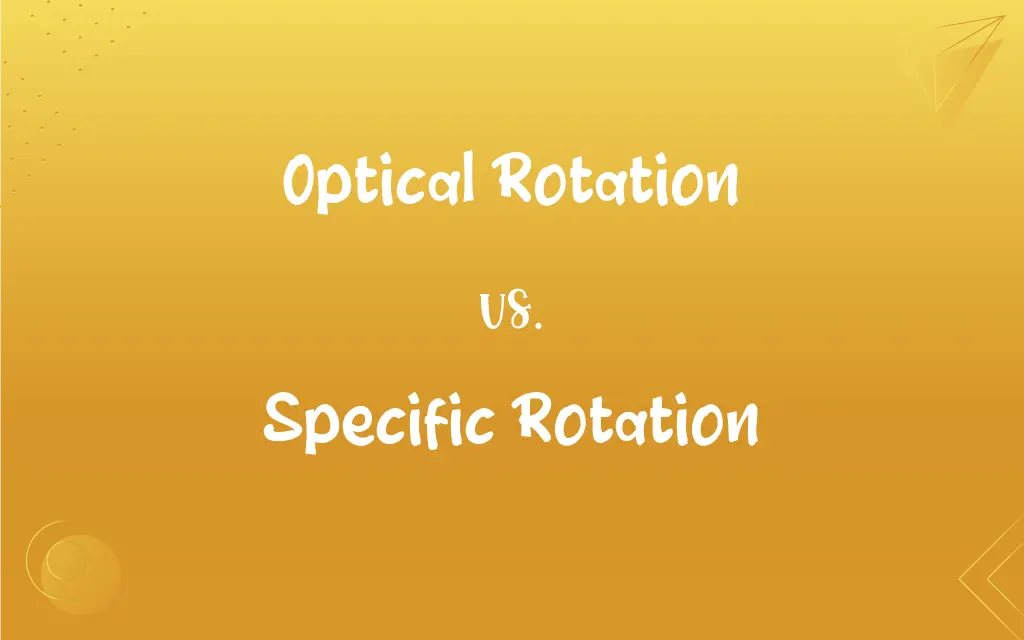Optical Rotation vs. Specific Rotation: What's the Difference?
Edited by Harlon Moss || By Aimie Carlson || Published on January 26, 2024
Optical rotation is the angle by which a substance rotates plane-polarized light, while specific rotation is this angle normalized to concentration and path length.

Key Differences
Optical rotation refers to the phenomenon where a chiral compound rotates plane-polarized light as it passes through. Specific rotation, on the other hand, quantifies this rotation by considering the concentration of the solution and the length of the path through which the light travels. Both concepts are intertwined in understanding chirality in substances.
The measurement of optical rotation is an empirical value, indicating the degree of rotation caused by a substance. In contrast, specific rotation is a standardized measure, allowing for comparisons between different substances. Optical rotation is the raw data, while specific rotation is the calculated value based on this data.
Optical rotation is often determined using a polarimeter, and the result is influenced by factors like temperature and wavelength. Specific rotation, however, is a constant for a given substance under specific conditions, representing a normalized version of optical rotation.
In studies of enantiomers, optical rotation provides direct observation of chirality. Specific rotation aids in identifying and characterizing these enantiomers by providing a consistent basis for comparison, irrespective of sample size or concentration.
Optical rotation is a straightforward measurement, while specific rotation requires additional information about the substance, such as its concentration and the solvent used. Both are crucial in fields like stereochemistry and pharmacology for understanding molecular structures and behaviors.
ADVERTISEMENT
Comparison Chart
Definition
Angle a substance rotates polarized light
Normalized measure of optical rotation
Dependence
Depends on substance, concentration, path length
Standardized against concentration, path length
Measurement
Empirical observation
Calculated value
Variability
Varies with conditions
Constant for a substance under specific conditions
Application
Direct observation of chirality
Comparison and characterization of chiral substances
ADVERTISEMENT
Optical Rotation and Specific Rotation Definitions
Optical Rotation
It's a measure of how much a substance can rotate polarized light.
The scientist noted the optical rotation to understand the compound's chirality.
Specific Rotation
It quantifies optical rotation per unit concentration and path length.
Specific rotation calculations helped compare different chiral solutions.
Optical Rotation
It's an indicator of molecular asymmetry in a substance.
The optical rotation helped differentiate between the two enantiomers.
Specific Rotation
Specific rotation is a critical parameter in stereochemistry for identifying chiral molecules.
The specific rotation values differed significantly, indicating distinct enantiomers.
Optical Rotation
Optical rotation is a property unique to chiral molecules affecting light's polarization.
The distinct optical rotation confirmed the presence of a specific enantiomer.
Specific Rotation
Specific rotation is a constant value for a substance under defined conditions.
The chemist referred to the specific rotation to verify the compound's purity.
Optical Rotation
Optical rotation is the rotation of plane-polarized light by a chiral compound.
The optical rotation of the solution changed significantly upon adding the chiral substance.
Specific Rotation
Specific rotation is the standardized measurement of optical rotation.
The specific rotation value was crucial for identifying the drug's active enantiomer.
Optical Rotation
Optical rotation reflects the degree of light rotation by optically active substances.
A high optical rotation value indicated a strong chiral influence in the sample.
Specific Rotation
It normalizes optical rotation for concentration and solution length.
Specific rotation allowed for a fair comparison between two different samples.
FAQs
Can optical rotation be negative?
Yes, depending on the direction of rotation of the polarized light.
What does a high specific rotation indicate?
It suggests a strong ability of the substance to rotate polarized light.
How is optical rotation measured?
Using a polarimeter.
Does the solvent affect specific rotation?
Yes, the choice of solvent can influence specific rotation values.
Can two substances have the same optical rotation?
Yes, but their specific rotations might differ.
What is optical rotation?
It's the angle by which a chiral substance rotates plane-polarized light.
How is specific rotation different from optical rotation?
Specific rotation is the normalized measure of optical rotation, accounting for concentration and path length.
Why is optical rotation important in chemistry?
It helps in understanding the chirality and molecular structure of substances.
Does the path length of light matter in optical rotation?
Yes, it affects the degree of rotation.
What happens to optical rotation if a solution is diluted?
The rotation angle decreases, but specific rotation remains constant.
Are all compounds optically active?
No, only chiral compounds exhibit optical activity.
Is optical rotation a physical or chemical property?
It's a physical property.
Does concentration affect optical rotation?
Yes, but specific rotation normalizes this effect.
Why do enantiomers show different optical rotations?
Due to their mirror-image molecular structures.
Can optical rotation be used to identify substances?
It can aid in identification, especially in chiral compounds.
Can optical rotation change with wavelength?
Yes, it's known as optical rotatory dispersion.
Is specific rotation affected by temperature?
Yes, it can vary with temperature changes.
Can specific rotation help in drug formulation?
Yes, it assists in identifying active chiral drug components.
What units are used for specific rotation?
Degrees per gram per milliliter (°/(g/mL)).
What is the significance of specific rotation in quality control?
It ensures consistency and purity of chiral substances in manufacturing.
About Author
Written by
Aimie CarlsonAimie Carlson, holding a master's degree in English literature, is a fervent English language enthusiast. She lends her writing talents to Difference Wiki, a prominent website that specializes in comparisons, offering readers insightful analyses that both captivate and inform.
Edited by
Harlon MossHarlon is a seasoned quality moderator and accomplished content writer for Difference Wiki. An alumnus of the prestigious University of California, he earned his degree in Computer Science. Leveraging his academic background, Harlon brings a meticulous and informed perspective to his work, ensuring content accuracy and excellence.






































































